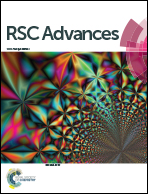Optical role of the thin metal layer in a TiOx/Ag/TiOx transparent and conductive electrode for organic solar cells†
Abstract
One possible alternative to ITO, the most commonly used transparent and conductive electrode (TCE) for Organic Solar Cells (OSCs) and other optoelectronic components, is to use an oxide|metal|oxide multilayer. Glass|cathode|ZnO (20 nm)|P3HT:PCBM (250 nm)|PEDOT:PSS (50 nm)|Ag (150 nm) inverted OSC structures are realized, where the cathode can be a TiOx|Ag|TiOx or ITO reference TCE. The sizing of the TiOx|Ag|TiOx (TAT) TCE structure is numerically realized by optimization of the normalized squared electric field inside the active P3HT:PCBM layer. The optimized TAT design in the whole design is different from the one involving optimization of transparency at the output of the trilayer structure in air. A photovoltaic efficiency of 2.7% is obtained for OSC with the TiOx (22 nm)|Ag (15 nm)|TiOx (19 nm) structure and can be compared to the 3.14% of efficiency obtained with the ITO reference. The short-circuit current density is identified as the crucial photoelectrical parameter. The morphology of the silver layer in TAT can give rise to an exaltation of the electromagnetic field, leading to an enhanced and undesirable absorption inside the metal layer. This exaltation is dependent of the thickness of the metal layer and induces changes in current density proportional to the normalized squared electric field inside this layer. The lost in short-circuit current density is estimated between 0.3 and 0.6 mA cm−2, and is comparable to a thickness variation of 20 nm for both TiOx layers or 2.5 nm of the silver layer. We define an exaltation coefficient of the bare electrode, which can be considered as a factor of merit to qualify the quality of the optical role of the silver layer and thereby of the trilayer electrode.



 Please wait while we load your content...
Please wait while we load your content...